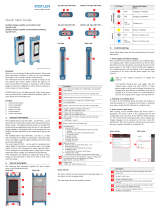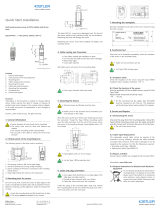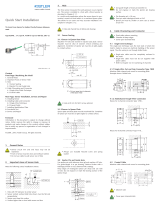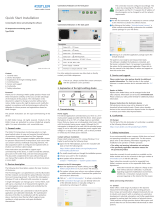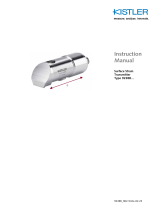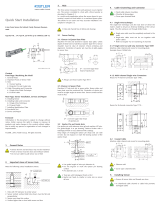
Manual
960-130e-02.23
Direct cavity
pressure sensors


Page 1
960-130e-02.23
Cavity pressure measurement oers the greatest poten-
tial for complete process monitoring and process control
in the injection molding process. A correct handling of the
pressure sensors is mandatory to utilize this potential.
This manual provides procedures and guidelines for sen-
sor-compliant handling during the entire application, start-
ing with the mold design, through the mold construction
and up to the machine operator. In addition, this manual
represents a product overview for direct cavity pressure
measurement and the respective accessories.
This manual was generated in cooperation with TE Con-
nectivity Ltd. Company. We are grateful to all participants
of TE Connectivity Ltd. Company for their valuable sug-
gestions and their constructive cooperation during the
creation and enhancement of this manual.
The information in this manual is subject to change at any
time without prior notice. Kistler reserves the right to im-
prove and modify the product in accordance with the tech-
nical progress without the obligation to inform persons
and organizations based on these changes.
© 2015 ... 2023 Kistler Group. All rights reserved.
Kistler Group
Eulachstrasse 22
8408 Winterthur
Switzerland
Phone +41 52 224 11 11
info@kistler.com
www.kistler.com
Foreword
Foreword

Direct cavity pressure sensors
960-130e-02.23
Page 2
Table of Contents
1. General Information ....................................................................................................................5
1.1 Warning Symbols and their Signicance ............................................................................6
1.2 Disposal Instructions for Electronic Devices .......................................................................6
2. Application...................................................................................................................................7
4. Design information .....................................................................................................................9
4.1 Sensor positioning ..............................................................................................................9
4.2 Positioning of contact elements ........................................................................................12
4.3 Sensor dimensions ...........................................................................................................14
4.4 Important points of the bore ..............................................................................................19
4.5 Surface quality of the mounting bore ................................................................................22
4.6 Mounting bore with spacer sleeve ....................................................................................23
4.7 Mounting bore with mounting nut .....................................................................................25
4.8 Mounting bore with conductive spacer sleeve ..................................................................28
4.9 Mounting bore with angled sensor ....................................................................................30
4.10 Mounting bore contact elements ......................................................................................31
4.11 Cable routing ....................................................................................................................33
4.12 Multi-channel connectors ..................................................................................................34
4.13 Sensor installation on tilted mold surfaces .......................................................................35
4.13.1 Sensor axis not at right angles to the mold surface ............................................35
4.13.1.1 Sensor installation with a part feature allowing for a at surface .........36
4.13.1.2 Sensor installation with machinable front ............................................37
4.13.2 Sensor axis right-angled to the mold surface ......................................................37
5. Installation of sensors ..............................................................................................................39
5.1 General .............................................................................................................................39
5.2 Important places of the bore .............................................................................................39
5.3 Installation recommendations ...........................................................................................39
5.3.1 Design of the mounting bore ...............................................................................39
5.3.2 Recommended work process for machining the mounting bore .........................41
5.4 Surface condition of the mounting bore ............................................................................44
5.5 Mounting bore with spacer sleeve ....................................................................................44
5.6 Mounting bore with mounting nut .....................................................................................44
5.7 Mounting bore with conductive spacer sleeve ..................................................................44
5.8 Mounting bore for angled sensors ....................................................................................44
5.9 Mounting bore for contact element ...................................................................................44

Page 3
960-130e-02.23
5.10 Checking the sensor bore .................................................................................................44
5.10.1 Checking and re-lapping of the bore ...................................................................44
5.11 Installation with spacer sleeve ..........................................................................................47
5.12 Machining spacer sleeve ..................................................................................................48
5.13 Installation with mounting nut ...........................................................................................49
5.14 Installation with conductive spacer sleeve ........................................................................50
5.15 Machining conductive spacer sleeve ................................................................................51
5.16 Sensor installation on tilted mold surfaces .......................................................................52
5.16.1 Sensor installation not at right angles to the mold surface ..................................52
5.16.1.1 Sensor installation with a part feature allowing for a at surface .........52
5.16.1.2 Sensor installation with machinable surface ........................................52
5.16.1.3 Information about machining the surface .............................................52
5.16.2 Sensor installation at right angles to the mold surface ........................................54
5.17 Contact element installation .............................................................................................54
5.18 Mounting examples ..........................................................................................................55
6. Cable and connection technology...........................................................................................58
6.1 Single-wire technology .....................................................................................................58
6.1.1 Single-wire repair with repair set 1207 ................................................................59
6.1.2 Exchange single-wire cable.................................................................................62
6.2 Contact elements ..............................................................................................................63
6.2.1 Fastening of the crimp contact at the single-wire cable ......................................64
6.2.2 Contact element with 1 channel for the charge transmission Type 1712 ............65
6.2.3 Contact element with 4 channels for the charge transmission Type 1714 ..........65
6.3 Cable routing ....................................................................................................................66
6.4 Connector installation .......................................................................................................66
6.4.1 Single channel connector Type 1839 ..................................................................67
6.4.2 Multi-channel connector Type 1708 and Type 1710 ............................................70
6.4.2.1 Mold identication ................................................................................74
6.5 Coaxial cable ....................................................................................................................74
6.6 Identication plate .............................................................................................................74
6.7 Installation support devices ..............................................................................................75
6.8 Accessories ......................................................................................................................76
7. Function test before the mold commissioning ......................................................................80
7.1 Handheld tester Type 5495...............................................................................................80
7.1.1 Utilization of the adapters ....................................................................................81
7.1.2 Connection with the sensor .................................................................................82
7.1.3 Sensitivity test .....................................................................................................82
7.1.4 Function test ........................................................................................................84
7.1.5 Insulation test ......................................................................................................85
7.2 Check the jamming of sensors .........................................................................................86

Direct cavity pressure sensors
960-130e-02.23
Page 4
8. FAQ .............................................................................................................................................87
8.1 Sensor provides no signal ................................................................................................87
8.2 Short circuit .......................................................................................................................87
8.3 The sensor shows values that are too low .......................................................................88
8.4 Drift ...................................................................................................................................88
8.5 Interfering signals (noise, leakage current) ......................................................................89
9. Service and repair .....................................................................................................................90
9.1 Handheld tester Type 5495...............................................................................................90
9.1.1 Utilization of the adapters ....................................................................................90
9.1.2 Connection with the sensor .................................................................................90
9.1.3 Sensitivity test .....................................................................................................90
9.1.4 Function test ........................................................................................................90
9.1.5 Insulation test ......................................................................................................90
9.2 Sensor removal ................................................................................................................91
9.2.1 Spacer sleeve......................................................................................................91
9.2.2 Mounting nut........................................................................................................91
9.2.3 Conductive spacer sleeve ...................................................................................91
9.2.4 Angled sensors....................................................................................................92
9.2.5 Auxiliary materials/accessories ...........................................................................92
9.2.6 Calibrating ...........................................................................................................92
9.3 Single wire repair ..............................................................................................................92
9.4 Exchange single wire ........................................................................................................92
9.5 Repairs at Kistler ..............................................................................................................93
9.6 Disposal instructions for electronic devices ......................................................................93
10. Appendix ....................................................................................................................................94
10.1 Checklist for the mold design ...........................................................................................94
10.2 Check-list for the mold shop .............................................................................................96
10.3 Test protocol sensor tester ...............................................................................................98
10.4 Diagrams for cause nding and troubleshooting ..............................................................99
10.4.1 No signal .............................................................................................................99
10.4.2 Short circuit .......................................................................................................104
10.4.3 The sensor shows values that are too low ........................................................108
10.4.4 Drift ....................................................................................................................113
10.4.5 Inuences by the power supply .........................................................................118
11. Supplemental history .............................................................................................................120
Total pages 127

General Information
Page 5
960-130e-02.23
1. General Information
Please take the time to thoroughly read this instruction
manual. It will help you with the installation, maintenance,
and use of this product.
To the extent permitted by law Kistler does not accept any
liability if this instruction manual is not followed or products
other than those listed under Accessories are used.
Kistler oers a wide range of products for use in measur-
ing technology:
Piezoelectric sensors for measuring force, torque,
strain, pressure, acceleration, shock, vibration and
acoustic-emission
Strain gage sensor systems for measuring force and
torque
Piezoresistive pressure sensors and transmitters
Signal conditioners, indicators and calibrators
Electronic control and monitoring systems as well as
software for specic measurement applications
Data transmission modules (telemetry)
Kistler also develops and produces measuring solutions
for the application elds engines, vehicles, manufacturing,
plastics and biomechanics sectors.
Our Sensors and Systems General Catalog (doc. no. 960-112)
provides an overview of our oering. Detailed data sheets
are available for practically all of the products.
The document numbering is based on the following pattern:
960-130d-07.15
960-130 is the internal document number which always
remains identical.
d represents the language of the document (d: German,
e: English, f: French)
07.15 is the creation date of the document and it will be
adapted accordingly with each revision.
If you need additional help beyond what can be found
either on-line or in this manual, please contact Kistler's
extensive support organization.

Direct cavity pressure sensors
960-130e-02.23
Page 6
1.1 Warning Symbols and their Signicance
Noncompliance with the precautionary measures de-
scribed here can lead to malfunctions or to damage to
system components (see table below).
Symbol Noncompliance Can Result In
CAUTION
Indicates a caution or warning notice.
NOTE
Indicates a tip or important information.
1.2 Disposal Instructions for Electronic Devices
Do not discard old electronic instruments in municipal
trash. For disposal at end of life, please return this product
to an authorized local electronic waste disposal service
or contact the nearest Kistler Instrument sales oce for
return instructions.

Application
Page 7
960-130e-02.23
2. Application
This manual exclusively describes direct measuring cav-
ity pressure sensors, which are mainly used in injection
molding tools. The application covers the entire range of
injection molding tools irrespective of whether these are
single or multi cavity systems.
The robust design permits reliable and continuous moni-
toring, analysis and optimization of injection molding pro-
cesses in industrial production.
The sensors described in this manual are not allowed to
be used either for measurements in the screw ante-cham-
ber or in distributors heated from the outside or in the hot
runner. In addition, they are not qualied for the pressure
measurement of gases and liquids.
3. Functional principle
As soon as the plastic melt ows into the mold and reaches
the sensor front, it applies a mechanical load on the sen-
sor. This deforms the quartz element of the sensor and an
electrical charge will be generated. The charge signal will
be routed through a connecting cable to a charge amplier,
which converts it into a voltage of 0 … 10 V. The individual
signals are proportional to each other. This means that the
measured voltage is proportional to the cavity pressure. It
can be acquired by the charge amplier and it can be used
for measurement and monitoring purposes.
The cavity pressure sensors developed by Kistler have
an almost unlimited service life as well as oering high
overload protection.
An approx. 0.01 mm wide annular gap separates the sen-
sor case from the wall of the mounting bore, which guar-
antees the free movement of the transmission rate (Fig.
3.1). This is required, because a parallel connection due
to jamming of the sensor results in measurement errors.
Under normal circumstances, the minimum dimensioning
of the annular gap prevents the plastic melt from penetrat-
ing into the gap.

Direct cavity pressure sensors
960-130e-02.23
Page 8
The annular gap for the sensors Type 6182C…, Type
6167A…, 6159A… and 6157B is sealed with a high
temperature resistant O-ring (Viton) to also prevent the
penetration of dirt. The O-ring is also used to center the
sensor (Fig. 3.1).
Fig. 3.1: Functional principle cavity pressure sensor
The material also penetrates the smallest gap openings
when processing very low viscosity molding compounds
(thermo-setting plastics, elastomers and SMC materials).
This can result in measurement errors or in extreme cases
in the destruction of the measuring element. Sensors with
diaphragms, Type 6161…, 6162… or 6163…, which were
especially developed for such materials, are used for the
processing of these molding compounds. The sensors
with diaphragms are not sensitive to the type of installa-
tion. Therefore, the mounting bore can be dimensioned
smaller to ensure that no plastic melt can penetrate the
annular gap during the process.
Single wire
connection cable
Spacer sleeve
Fastening ange
Quartz package
O-ring
Pressure p
Pressure p
Annular gap

Design information
Page 9
960-130e-02.23
4. Design information
It is important for the placement of the sensors to decide
which objectives are pursued with the recording of the
cavity pressure. For example, the optimal sensor position
for process control can be dierent from the optimal posi-
tion for monitoring.
To prevent problems during process monitoring, it is im-
portant to position the sensor in accordance with the re-
quirements of the measuring signal and the monitoring
task. In addition, adherence to the requirements of the
mounting bore is required. This section will provide pro-
cedures about the design of the mounting bore and the
positioning of the sensor.
4.1 Sensor positioning
The selection of the sensor position is of signicant impor-
tance to get meaningful results from the cavity pressure
curve. It must be noted that the optimal position depends
on the requirements or the objectives. If the cavity pres-
sure will be used as a control variable for switching to the
holding pressure, the sensor must be placed near the gate
(Fig. 4.1). This means that the process monitoring already
starts during the injection phase. If the sensor is placed
in the area of the highest wall thickness, the number of
iterations for the complete lling can be reduced signi-
cantly, because this area solidies last and therefore the
pressure signal is maintained longest (Fig. 4.2). The sen-
sor must be positioned at the end of the ow path for the
monitoring of short shots. A ll study or a mold ow analy-
sis can be helpful during the mold trials of a new mold. A
second sensor at the end of the ow path can be sensible
for monitoring certain process-typical errors (Fig. 4.3).

Direct cavity pressure sensors
960-130e-02.23
Page 10
Fig. 4.1: Positioning near the gate
Fig. 4.2: Positioning in the area of the highest
wall thickness

Design information
Page 11
960-130e-02.23
Fig. 4.3: Positioning of a second sensor
For molds with several gates, the sensors must be posi-
tioned at the critical point of the material conuence to be
able to monitor them.
However, the optimal position cannot always be used. In
many cases, geometrical conditions force the user to se-
lect the second or third best installation location. In these
cases, the aspect of the sensor position must always be
included in the interpretation of the measuring results.
As a matter of principle, the sensor must not be positioned
in the sprue or across the gate. The sensor does not de-
liver any process information for the component quality
when placed in the sprue channel (Fig. 4.4). If the sensor
is positioned across the sprue, the impacting plastic melt
distorts the measuring signal. In addition, the sensor front
will be washed out, which signicantly shortens the ser-
vice life (Fig. 4.5).

Direct cavity pressure sensors
960-130e-02.23
Page 12
Fig. 4.4: No positioning of the sensor in the sprue
Fig. 4.5: No positioning of the sensor opposite the gate
4.2 Positioning of contact elements
Contact elements are used for the easy dismounting of
mold inserts for maintenance and repair work. They
should be positioned in such a way that they do not come
into contact with water or with moisture, not even during
service and repair work. In addition, contact elements
should be placed at a distance to the cooling channels as
large as possible.

Design information
Page 13
960-130e-02.23
Contact elements can be designed with 1-channel or
4-channel. Both options are shown in Fig. 4.6 and 4.7.
Fig. 4.6: Contact element with one conductive channel
Fig. 4.7: Contact element with 4 conductive channels
The provided mounting nut is used for the installation or,
if enough space is available, a small steel plate is used.
These small steel plates are not an accessory delivered
by Kistler because they must be created and produced
individually for each installation situation. This is the only
way to maintain the maximal possible exibility. The small
steel plates are shown in Fig. 4.8.

Direct cavity pressure sensors
960-130e-02.23
Page 14
30
ø10,1
±0,1
16
21
9,6 ±0,1
8±0,1 1x45°
R1,5
ø4,2
ø8
90°
2
30
ø10,1
±0,1
16
21
9,6 ±0,1
8±0,1 1x45°
R1,5
ø4,2
ø8
90°
2
Fig. 4.8: Small steel plate for mounting the contact ele-
ment Type 1714…
When using this retaining plate for a 4-channel contact
element, it must be ensured that the retaining plate pre-
vents the rotation of the contact elements.
A mounting example for the contact element, Type 1712…,
is shown in Fig. 4.9.
Fig. 4.9: Mounting example contact element
4.3 Sensor dimensions
The dimensioned sensor drawings are shown in the fol-
lowing sections. The sensors are arranged in descending
type numbers. The angled sensor, Type 6184, is listed at
the end of this section.

Design information
Page 15
960-130e-02.23
11.5 0
-0.05
4 0
-0.05
2.5 g6 -0.002
-0.008
()
1-0.01
-0.02
2.2 0
-0.02
18
23
Fig. 4.10: Dimension sensor Type 6183C… and 6183D...
Fig. 4.11: Dimension sensor Type 6183B.../6183AQ100/
6183DYQ100

Direct cavity pressure sensors
960-130e-02.23
Page 16
10
2kt. SW3,5
0
-
-0,020
0,03
12
2,5 e6
-
21,6
0,014
0,002
0,008
2,5 g6 -
-
0,6
Fig. 4.12: Dimension sensor Type 6182C… and 6183D...
Fig. 4.13: Dimension sensor Type 6159…
O-ring
Type 1100A55

Design information
Page 17
960-130e-02.23
Fig. 4.14: Dimension sensor Type 6157..., 6167..., 6177...
Fig. 4.15: Dimension sensor Type 6152..., 6172...,
6162..., 6163...
O-ring
Type 1100A55

Direct cavity pressure sensors
960-130e-02.23
Page 18
Fig. 4.16: Dimension sensor Type 6184
Page is loading ...
Page is loading ...
Page is loading ...
Page is loading ...
Page is loading ...
Page is loading ...
Page is loading ...
Page is loading ...
Page is loading ...
Page is loading ...
Page is loading ...
Page is loading ...
Page is loading ...
Page is loading ...
Page is loading ...
Page is loading ...
Page is loading ...
Page is loading ...
Page is loading ...
Page is loading ...
Page is loading ...
Page is loading ...
Page is loading ...
Page is loading ...
Page is loading ...
Page is loading ...
Page is loading ...
Page is loading ...
Page is loading ...
Page is loading ...
Page is loading ...
Page is loading ...
Page is loading ...
Page is loading ...
Page is loading ...
Page is loading ...
Page is loading ...
Page is loading ...
Page is loading ...
Page is loading ...
Page is loading ...
Page is loading ...
Page is loading ...
Page is loading ...
Page is loading ...
Page is loading ...
Page is loading ...
Page is loading ...
Page is loading ...
Page is loading ...
Page is loading ...
Page is loading ...
Page is loading ...
Page is loading ...
Page is loading ...
Page is loading ...
Page is loading ...
Page is loading ...
Page is loading ...
Page is loading ...
Page is loading ...
Page is loading ...
Page is loading ...
Page is loading ...
Page is loading ...
Page is loading ...
Page is loading ...
Page is loading ...
Page is loading ...
Page is loading ...
Page is loading ...
Page is loading ...
Page is loading ...
Page is loading ...
Page is loading ...
Page is loading ...
Page is loading ...
Page is loading ...
Page is loading ...
Page is loading ...
Page is loading ...
Page is loading ...
Page is loading ...
Page is loading ...
Page is loading ...
Page is loading ...
Page is loading ...
Page is loading ...
Page is loading ...
Page is loading ...
Page is loading ...
Page is loading ...
Page is loading ...
Page is loading ...
Page is loading ...
Page is loading ...
Page is loading ...
Page is loading ...
Page is loading ...
Page is loading ...
Page is loading ...
Page is loading ...
/



